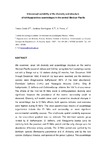Interannual variability of the diversity and structure of ichthyoplankton assemblages in the central Mexican Pacific

Use este enlace para citar
http://hdl.handle.net/2183/127Coleccións
- Investigación (FCIE) [1260]
Metadatos
Mostrar o rexistro completo do ítemTítulo
Interannual variability of the diversity and structure of ichthyoplankton assemblages in the central Mexican PacificData
2004Resumo
[Abstract] We examined larval fish diversity and assemblage structure on the central
Mexican Pacific (coast of Jalisco and Colima) using data from samplings carried
out with a Bongo net at 12 stations during 27 months, from December 1995
through December 1998. A total of 132 taxa were recorded, and the dominant
species were Bregmaceros bathymaster (90% of the total abundance),
Dormitator latifrons (1.9%) and Harengula thrissina (0.8%). Only B.
bathymaster, D. latifrons and Gobionellus sp. attained the 100 % of occurrence.
The effects of the 1997-98 El Niño event in ichthyoplankton diversity were
significant, however the prevalence of the normal seasonality could be
observed. Diversity null models were used to determine structural changes in
the assemblage due to El Niño effects; both species richness and evenness
were highest during El Niño. The most parsimonious models of assemblage
organization include the El Niño and seasonality as most significant
environmental variability sources. The small-scale spatial variability expressed
as the cross-shore gradient was not relevant. The dominant species group
formed by B. bathymaster, D. latifrons, and Vinciguerria lucetia typify for
similarity both the previous and El Niño period and the only change was the
abundance difference among periods. The El Niño period was typified by the
dominant species Bentosema panamense and H. thrissina, and by the rare
species Euthynus lineatus, and species of the genus Lujtanus. The assemblage
shows a similar organization in the different seasons, sharing the same
dominant species group. Seasonality produces only changes in the abundances
and relative frequencies of dominant species and different rare species are
characteristic of the different seasons. The average taxonomical distinctness,
that could be considered as a measure of functional diversity, was highly
sensitive to the seasonal change of the assemblages independently of the El
Niño; this index showed lowest values during tropical and transition periods
characterized by warm and oligotrophic waters
Palabras chave
El Niño southern oscillation
Fish larvae
Diversity null models
Taxonomical distinctness
Species richness
Evenness
Assemblages
Tropical Pacific
Fish larvae
Diversity null models
Taxonomical distinctness
Species richness
Evenness
Assemblages
Tropical Pacific





